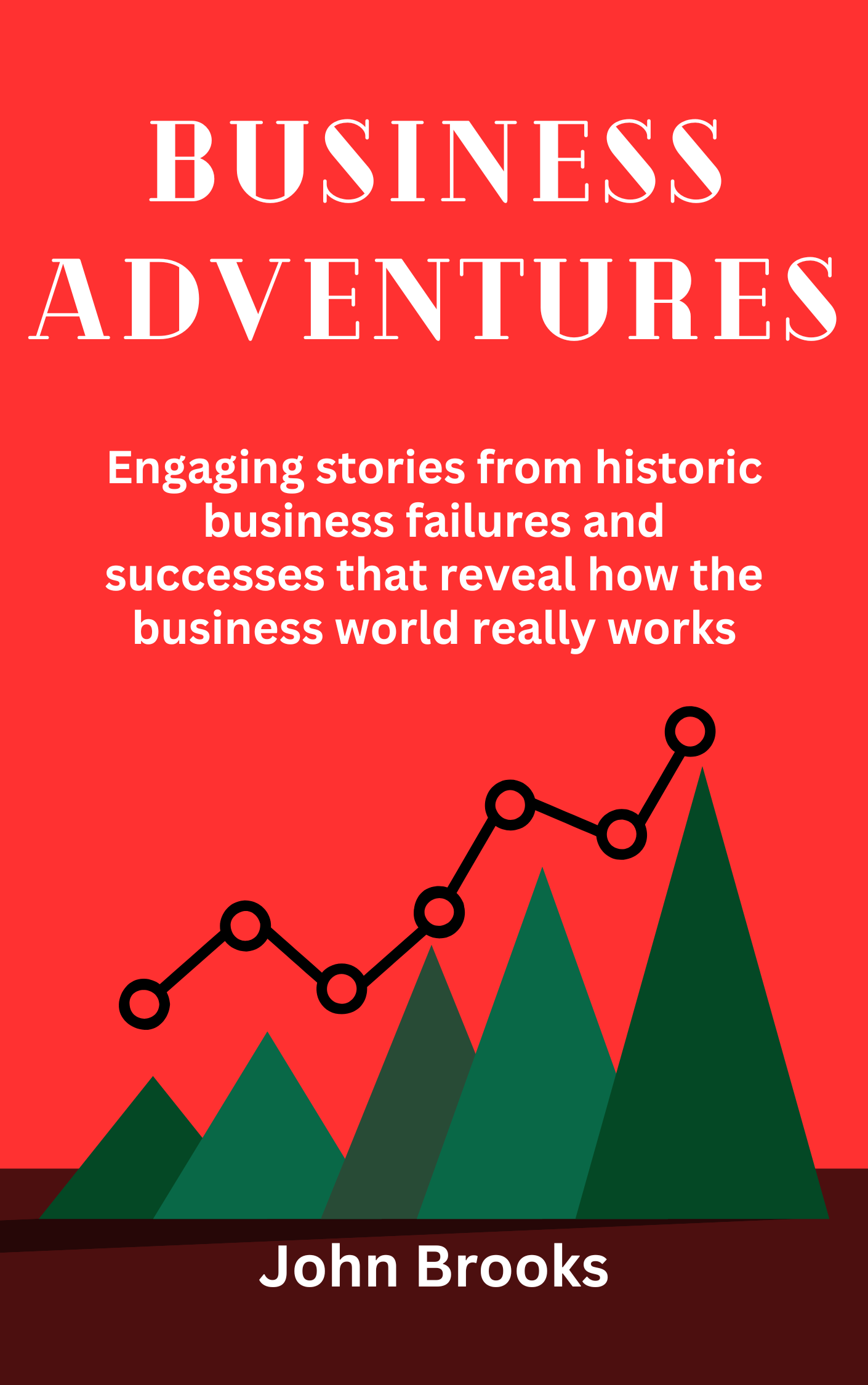Introduction
Financial writer John Brooks takes us behind the scenes of Wall Street's most fascinating stories. His 1969 classic isn't your typical dry business book - it's a collection of true tales that read like financial thrillers. Brooks unpacks the 1962 market crash, Xerox's remarkable rise, and Ford's expensive Edsel disaster. He tells us how Piggly Wiggly's founder tried to outsmart Wall Street, why GE's top executives couldn't communicate with each other, and what really happened when sterling faced its biggest crisis. Each story reveals timeless truths about money, markets, and human nature that still matter today. As Warren Buffett notes, these lessons never get old.
Let's begin!
The Only Constant is Fluctuation!
If you've ever wondered what real panic looks like, this would show you.
One Monday in May 1962, the stock market had its second-worst drop ever. Stocks lost $20.8 billion in value! People were selling stocks so fast that even the machines couldn't keep up. The poor ticker tape (old-school Twitter for stock prices) fell behind by over an hour. But then, the very next day, everyone suddenly decided they wanted to buy instead of sell. Why? Because telephone company AT&T's stock hit $100. That's it. Just a round number made people feel better.
This circus teaches us something crucial: the stock market isn't run by cool-headed math wizards, but by regular humans who panic, get excited, and make decisions based on feelings. Even the smartest Wall Street folks couldn't explain why everyone freaked out that day. Here's your lesson in all this: the people who kept their cool generally fared better than the panicked sellers. As financier J.P. Morgan quipped when asked what the market would do: "It will fluctuate." Instead of trying to time these swings, consider following what worked in 1962: keep some cash handy, look for bargains when others panic, and remember that even the worst market days eventually end.
Our next story is about a lemon!
Functional, not perfect!
Ford spent a fortune, about $2.5 billion in today's money, creating what they thought would be the perfect car. They researched exhaustively, hired the best talent, and promoted it like crazy. The result? The Edsel - a car whose front grille looked like, as critics noted, "an Oldsmobile sucking a lemon."
The story is deliciously ironic. Ford's marketing whizzes spent countless hours picking the perfect name, only to ignore all their research and name it "Edsel" after the founder's son. They promised revolutionary design but delivered a car that one customer said had "doors cockeyed" and a "header bar trimmed at the wrong angle." They even had a dealer's demonstration where the brakes failed spectacularly - talk about a sales pitch gone wrong!
But here's what makes this 1957 story relevant today: Ford did everything by the book. Market research? Check. Big budget? Check. Massive advertising? Check. Yet they still failed because they forgot the basics - make sure the product works, don't overhype it, and sometimes simple is better than "revolutionary."
Next time you're working on a project, ask yourself: Am I building an Edsel? Are you focusing so much on the perfect plan that you're missing obvious flaws? Sometimes the best innovation isn't the flashiest - it's the one that simply works.
Now! Let's talk taxes.
The Great American Tax Tale
For our third story, Brooks takes us on a fascinating journey through America's complicated relationship with income tax. In 1913, when the tax first started, it was simple - rich folks paid a bit, everyone else paid nothing. Fast forward to today, and we've got a system so complex it needs super-computers to keep track of who owes what. Wars changed it. World War II turned tax from a rich person's burden into everyone's business.
But here's where it gets tragic - while regular workers started paying more, the wealthy found creative exits. Take oil barons, for example. Normally, when a business buys something expensive like machinery, they can claim a tax deduction for the item's wear and tear, but only until they've recovered the original cost of the item. But oil companies could deduct 27.5% of their income from an oil well EVERY SINGLE YEAR, even after they'd already recovered the original cost of drilling the well. And stock market profits got special treatment. And that's the irony! In a democracy where the majority rules, how did we end up with tax breaks that mostly help the rich? The answer lies in public indifference and powerful lobbying. As he notes, most people are "stunned into incomprehension" by tax complexity - and that's exactly how some prefer it.
Reformers dream of returning to 1913's simplicity - making our ultra-modern tax system's ultimate aspiration a return to its humble beginnings. Perhaps that's the most telling commentary on a century of 'progress' in American taxation. Anyway! Moving on.
At Wall Street, Secrets Become Currency
In the shadowy world of stock trading, information has always been more valuable than gold. The Texas Gulf Sulphur case isn't just a legal drama—it's a revealing peek into the heart of financial ethics.
Picture a remote Canadian wilderness where a group of geologists stumble upon a mineral deposit worth millions. But before announcing their discovery, several company insiders start buying stock on the quiet. It's like finding buried treasure and telling only your closest friends before the map goes public.
The Securities and Exchange Commission pounced. Their argument? These insiders were playing a rigged game, using privileged knowledge to line their own pockets while ordinary investors remained in the dark. Judge Bonsal's courtroom became a battlefield of corporate morality. Was it insider trading or just savvy investment? The nuances were deliciously complex. Some argued that insider stock purchases incentivize corporate performance. Others saw it as nothing short of financial manipulation.
The ultimate lesson? Markets function on trust. When insiders exploit information asymmetry, they're not just breaking rules—they're undermining the fundamental contract between companies and shareholders. They're eroding trust that makes financial markets possible. So, next time you invest, ask yourself: What don't I know? And more importantly, who might know more than me?
Lessons from Xerox's Rise
In 1938, Chester Carlson worked late in his kitchen laboratory above a Queens bar, trying to solve a common office problem: making copies of documents. Back then, if you needed five copies of something, you had to write it five times or pay someone to do it. After countless attempts and some strange-smelling experiments, Carlson created the first xerographic copy - just a simple date and location: "10-22-38 ASTORIA." But...
Nobody cared. For five years, every major company turned him down. Then a small Rochester company called Haloid took a chance. They spent millions developing Carlson's invention. The risk paid off spectacularly - by the 1960s, people were making billions of copies yearly, and early Haloid investors saw their stock grow 180 times in value.
Success brought challenges. Some users copied copyrighted materials illegally. The company struggled to maintain its family feel as it grew from 1,000 to 20,000 employees. But, under Joe Wilson's leadership, Xerox took bold stands - like supporting the United Nations through TV programs even when 15,000 protest letters from right wingers flooded in against the UN.
Perhaps your lesson from Xerox's story is that in business, as in life, the greatest successes often come not just from what you make, but from how you choose to make a difference.
On to story 6!
The Day Wall Street Put People First
In November 1963, Wall Street faced a problem that threatened to destroy thousands of people's savings. A stockbroker firm called Ira Haupt & Co. had made a terrible mistake - they trusted a fraudster who gave them fake warehouse receipts for oil that didn't exist. When this fraud was discovered, Haupt couldn't pay back its debts. More importantly, 20,000 innocent customers who had nothing to do with oil trading couldn't access their stocks or money.
What happened next was unprecedented. The New York Stock Exchange, led by Keith Funston, decided to use its own money - a whopping $9.5 million - to rescue these customers - and avert a possible market crash. Funston spent a sleepless weekend running between rooms like a "combination messenger boy and envoy," convincing stubborn bankers and exhausted partners to agree to his plan. The Stock Exchange would put up $7.5 million to help the customers. In exchange, the banks that Haupt owed money to would agree to wait before demanding their money back. Instead of letting Haupt handle things, the Exchange would put their own person in charge of returning money to customers. By March 1964, almost everyone had their money back.
These financial leaders showed that even Wall Street could put people before profits. Sometimes the best solution is working together!
With that, let’s talk about corporate lingo.
Corporate Double-Speak and Ethics
In 1961, General Electric, America's fifth-largest company, got caught playing a rather expensive game of "I didn't hear that." Top executives at GE were secretly meeting competitors to fix prices on electrical equipment, driving up costs for everyone from local governments to your grandmother's power bill.
When caught, GE's leadership put on a masterclass in corporate confusion. Mid-level managers claimed they got orders with "winks," while top brass insisted they'd been crystal clear about following the law. One executive, Raymond Smith, thought saying "meeting with the clan" clearly meant price-fixing meetings. His boss claimed he thought Smith was talking about casual office gatherings. Another executive, Mr. Ginn, even blamed his misdeeds on losing his "air cover" - corporate speak for "my boss who let me break rules isn't here anymore."
The fallout? Millions in fines, executives in jail, and enough lawsuits to keep lawyers busy for years. GE's defense boiled down to "we're not corrupt, we're just really bad at talking to each other!"
Point being, organizations and executives use fuzzy communication to dodge responsibility. So watch out! Next time your boss says "handle it your way," ask yourself: Is this a genuine instruction or a GE-style wink? The most unethical thing isn't the action itself - it's the carefully crafted ambiguity that enables it.
Next lesson, next company.
The Man Who Almost Beat Wall Street
Ever wonder why you can grab your own groceries instead of having a clerk do it for you? Thank Clarence Saunders, the same fellow who nearly brought Wall Street to its knees in 1923. Operating out of Memphis, Saunders created Piggly Wiggly, America's first self-service grocery store. He got rich, built a massive pink marble mansion, and was living the high life until Wall Street traders started betting against his company's stock. They borrowed Piggly Wiggly shares from brokers. They sold these borrowed shares immediately at $50. They spread rumors about the company failing. This made the stock price fall to $40. Their plan was to buy shares back at $40, return them to the brokers, and keep the $10 difference as profit.
Saunders didn't take this lying down. He borrowed $10 million (that's like $170 million today) and started buying up every Piggly Wiggly share he could find. His plan? This meant when the short sellers needed to return their borrowed shares, they could only buy them from him at whatever price he named - a move called "cornering" the market. He almost succeeded too, driving the stock price from $39 to $124. But Wall Street changed its own rules mid-game. They suspended trading of Piggly Wiggly stock. This let short sellers hunt down small shareholders and buy from them instead giving traders extra time to find shares elsewhere. Saunders lost everything.
Yet Saunders never gave up. He bounced back multiple times, creating new store chains and even dreaming up an automated grocery store called Keedoozle (think Amazon Go, but in the 1930s). Saunders shows us something vital: failure isn't final unless you stop trying.
Ready for the next lesson?
Business with a Soul
David Lilienthal wasn't your typical businessman. Picture a guy who ran the Tennessee Valley Authority and the Atomic Energy Commission, two of the most powerful government institutions of his time. Lilienthal was a visionary who believed in using large-scale systems to solve real human problems. When he left government in 1950, he dove headfirst into the business world - not to make a quick buck, but to prove that business could be a force for genuine social good.
Lilienthal wasn't motivated by money. His journal entries reveal a deeper purpose. He wanted to understand business from the inside, to see how corporate mechanisms could be used to solve real-world problems.
After making some huge bucks, this philosophy later culminated in his most significant post-government achievement: the Development & Resources Corporation (D&R). This wasn't just another consulting firm. It was a revolutionary concept where business expertise met social development. D&R worked with governments worldwide, helping develop resources in places like Iran's Khuzistan region - transforming barren landscapes into productive territories.
His unwavering belief that business could be ethical and impactful is something all of us can learn from. He challenged the notion that profit and social good were mutually exclusive. In fact, in his book "Big Business: A New Era", he argued that large corporations could actually promote individualism and reduce poverty.
Let’s talk stockholders now!
Stockholder Meetings Reveal the Real Power Behind Big Business
When most people think of big corporations, they imagine faceless giants making decisions behind closed doors. But the reality is the annual stockholder meeting - a corporate circus where ordinary people who own tiny pieces of massive companies get to ask questions directly to the top brass.
Professional stockholders are the unexpected heroes of this story. These aren't your typical investors. They're persistent, sometimes eccentric individuals who make it their mission to challenge corporate leadership. Take Wilma Soss and Lewis Gilbert of the American Telephone & Telegraph (A.T.&T.). At A.T.&T. meeting in Detroit, Chairman Frederick Kappel sat stern-faced, fielding questions from stockholders. Mrs. Soss challenged the company on everything from director nominations to disclosure practices. When things got heated, Kappel simply turned off her microphone - a move that speaks volumes about corporate power dynamics.
The pattern repeated across companies. At RCA, stockholders practically worshipped their legendary chairman David Sarnoff. So what can you learn from this corporate theater?
Real power isn't about ownership - it's about engagement. These meetings reveal that most stockholders are passive, content with dividends and glowing reports. True accountability comes from those willing to ask tough questions, even when everyone else is cheering. So, whether in a workplace, community, or personal relationship, change comes from those brave enough to speak up!
For our 11th business tale…
One Free Bite
This is the story of Donald Wohlgemuth, a space-suit engineer whose career move sparked a landmark legal battle that would become a cornerstone of trade secrets law.
We're in 1962 America: Science was racing toward the moon. Donald Wohlgemuth, a chemical engineer, was working for B.F. Goodrich, a company renowned for pioneering high-altitude and space suits. At 31, he was managing Goodrich's space-suit engineering department, having contributed significantly to the Mercury astronaut suit designs.
When International Latex - another company - offered Wohlgemuth a better job, he didn't hesitate. His move triggered a legal storm of employee rights and corporate intellectual property.
Goodrich wasn't just upset; they were existentially concerned. They believed Wohlgemuth carried their trade secrets in his mind which Latex would exploit to leap ahead.
The legal principle at the heart of this drama? One free bite - borrowed charmingly from dog bite law. Just as a dog isn't considered vicious until it actually bites someone, Wohlgemuth couldn't be preemptively stopped from working unless there was clear evidence he intended to misuse secrets. The one free bite principle teaches us that intent matters. Professionals can change jobs and use their general skills and knowledge, but they cannot deliberately exploit specific proprietary processes learned in a previous role.
And just like that, we have reached the last story!
How Global Bankers Saved a Currency from Collapse
In 1964, The British pound, once the most powerful currency in the world, was under siege. Speculators—financial predators who bet against currencies—were convinced they could force Britain into a humiliating devaluation. Opposite them stood Alan Hayes from the New York Federal Reserve and Lord Cromer from the Bank of England. The pound wasn't just a currency; it was a national symbol. So, Hayes and Cromer weren't just protecting numbers on a spreadsheet, but the very economic dignity of a nation.
The crisis went like this. Speculators were selling pounds faster than Britain could defend them, driving the currency's value down. By November 1964, the situation looked dire. The Bank of England was desperately trying to maintain the pound's value. Then came the masterstroke. Hayes and Lord Cromer orchestrated an unprecedented international rescue operation. In just one morning, they persuaded central banks from around the world—Germany, Canada, Italy, Switzerland—to contribute - a global act of economic solidarity. This made up a massive $3 billion credit line!! The Bank of England could now buy massive amounts of pounds in the market. They strategically placed bids, confused speculators, and forced the speculators to retreat!
The operation worked. The pound stabilized, and for a moment, international cooperation seemed not just possible, but powerful. But this wasn't a one-time miracle. Over the next few years, these bankers repeated this delicate dance multiple times, each rescue more nuanced than the last.













